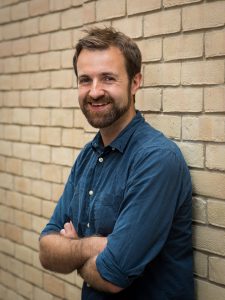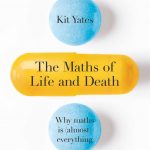Dr Kit Yates, author of The Maths of Life and Death, discusses the many places where maths appears in everyday life and shows us some simple mathematical tools to help cut through dubious statistics and political half-truths.
Maths can be an unloved subject, viewed as overly hard, abstract and removed from everyday concerns. Why do you think that is?
There’s no doubt that maths is perceived as polarising; despised by many and loved by just a few. As a mathematician interested in sharing the wonders of my subject, my biggest struggle is with this self-imposed false dichotomy: those who believe that they can do maths and those who think they can’t. There are far too many of the latter. But there is almost no-one who understands no maths at all, no-one who cannot count.
At the other extreme, for hundreds of years there have been no mathematicians who understand all of known mathematics. We all sit somewhere on this spectrum; how far we travel to the left or to the right depends on how much we think this knowledge can be useful to us. Exposing the uses and importance of maths in everyday life is one way to shift people along the spectrum, to bring them into the middle ground.
This is exactly what I’ve tried to do in my book. It’s important to say upfront that The Maths of Life and Death is not a maths book. Nor is it a book for mathematicians – there isn’t a single equation in it. The point of the book is not to bring back memories of the school mathematics lessons you might have given up years ago. Quite the opposite. If you’ve ever been disenfranchised and made to feel that you can’t take part in mathematics or aren’t good at it, consider this book an emancipation.
Is this attitude to maths changing?
I think atittitudes are slowly changing towards the importance of maths. As our economies change, there is a growing awareness that we need more mathematicians, engineers and scientists to fill the increasing numbers of jobs in the technology sector. To some degree this is reflected in maths’ rise to becoming the most popular A-level choice. This rise in popularity has also impacted on the number of students continuing to study mathematics in higher education. I always tell students who come to visit my department at open days, and who are trying to make up their mind about whether to study maths or not, that by studying maths they will only open doors for themselves and never close them. It’s so easy to jump out of mathematics and into another discipline, but much harder to go back the other way.
For example, I myself am a mathematical biologist. I dropped biology at sixth-form and took A-levels in maths, further maths, physics and chemistry. When came up to Somerville, I had to further streamline my subjects, and felt sad that I had to leave biology behind forever; a subject I thought had incredible power to change lives for the better. I was hugely excited about the opportunity to plunge myself into the world of mathematics, but I couldn’t help worrying that I was taking on a subject that seemed to have very few practical applications. I couldn’t have been more wrong. I learned that mathematics can be used to describe almost everything. Now I work in collaboration with experimentalists acorss the globe in order model a wide range of biological phenomena. I try to answer questions as diverse as “How can we stop locusts from forming devastating swarms?” and “How can we help the immune system to better battle parasites?”, to “How do eggs get their often beautiful patterns?” and “How did Sylvester the cat get his black and white coat?”.
I think as people start to see the way in which mathematics is increasingly pervading their everyday lives and to understand how even a little mathematical knowledge can be of benefit in real life, its importance will be increasingly realized. I also believe that when students see that there is a point to the maths they are being taught, rather than just rote learning to pass an exam, that maths can be transformed into something enjoyable.
This is what The Maths of Life and Death is all about. I try to convince the reader that maths is so much more than the esoteric subject they left behind at school. It is the false alarms that play on our minds and the false confidence that helps us sleep at night; the stories pushed at us on social media and the memes that spread through it. Maths is the loopholes in the law and the needle and thread that closes them; the technology that saves lives and the mistakes that put them at risk; the outbreak of a deadly disease and the best way to control it. It is the best hope we have of answering the most fundamental questions about the enigmas of the cosmos and the mysteries of our own species. It leads us on the myriad paths of our lives and lies in wait, just beyond the veil, to stare back at us as we draw our final breaths.
How are we using maths intuitively in everyday life?
I genuinely believe that maths is for everyone and that we can all appreciate the beautiful mathematics at the heart of the complicated phenomena we experience daily. If you’ve ever been made to feel that you can’t comprehend maths or aren’t good at it, I say this: you are experiencing it all the time, perhaps without even knowing it. Mathematics, at its most fundamental, is pattern. If you spot a motif in the fractal branches of a tree, or in the multi-fold symmetry of a snowflake, then you are seeing maths. When you tap your foot in time to a piece of music, or when your voice reverberates and resonates as you sing in the shower, you are hearing maths. If you bend a shot into the back of the net or catch a cricket ball on its parabolic trajectory, then you are doing maths. Part of the job I undertake in the book is to highlight the places where people are using maths, intuitively, perhaps without even realising it.
A common everyday use of maths is in shopping – a trip to the greengrocer is one of the most cited examples in school maths teaching – but what are some other everyday, and more unusual uses of maths?
It’s funny you should mention shopping, because in the book I provide a nice rule of thumb called ‘the 37% rule’ which uses the maths of optimisation to help you join the shortest queue in the supermarket.
Of course there are so many more places where maths appears in everyday life. In the book, we explore the true stories of life-changing events in which the application (or misapplication) of mathematics has played a critical role: patients crippled by faulty genes and entrepreneurs bankrupt by faulty algorithms; innocent victims of miscarriages of justice and the unwitting victims of software glitches. I follow stories of investors who have lost fortunes and parents who have lost children, all because of mathematical misunderstanding. I wrestle with ethical dilemmas from screening to statistical subterfuge and examine pertinent societal issues such as political referenda, disease prevention, criminal justice and artificial intelligence. I show that mathematics has something profound or significant to say on all of these subjects, and more.
Rather than just pointing out the places in which maths might crop up, I also try to arm the reader with simple mathematical rules and tools which can help them in their everyday life: from getting the best seat on the train, to keeping one’s head when on the receiving end of an unexpected test result from the doctor. I suggest simple ways to avoid making numerical mistakes and get my hands dirty with newsprint when untangling the figures behind the headlines. I also get up close and personal with the maths behind consumer genetics and display maths in action as I highlight the steps we can all be taking to help halt the spread of deadly diseases.
What are some of the benefits of a better understanding of maths?
A little mathematical knowledge in our increasingly quantitative society can help us to harness the power of numbers for ourselves. Simple rules allow us to make the best choices and avoid the worst mistakes. Small alterations in the way we think about our rapidly evolving environments help us to ‘keep calm’ in the face of accelerating change, or adapt to our increasingly automated realities. Basic models of our actions, reactions and interactions can prepare us for the future before it arrives. The stories relating other people’s experiences are, in my view, the simplest and most powerful models of all.
Half the battle for mathematical empowerment is daring to question the perceived authority of those who wield the weapons – shattering the illusion of certainty. Appreciating absolute and relative risks, ratio biases, mismatched framing and bias gives us the power to be sceptical of the statistics screamed from newspaper headlines, the ‘studies’ pushed at us in adverts or the half-truths that come tumbling from the mouths of our politicians. Recognising mathematical sleights of hand allows us to disperse obfuscating smoke screens, making it harder to fool us with mathematical arguments, be they in the courtroom, the classroom or the clinic.
As I hope I show throughout the book, it is time for us to take the power back into our own hands, because sometimes maths really is a matter of life and death.
Dr Kit Yates is the author of The Maths of Life and Death – how mathematics plays a crucial role in helping us navigate the real world.’ The book is published in the UK on September 5th and the US in Spring 2020, and is available for pre-order online.

